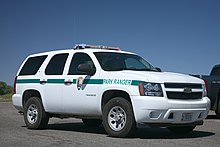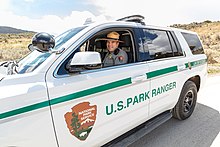| National Park Service Law Enforcement Rangers | |
|---|---|
 Badge Badge | |
| Common name | Law Enforcement Ranger |
| Agency overview | |
| Formed | 1916 |
| Jurisdictional structure | |
| Federal agency (Operations jurisdiction) | United States |
| Operations jurisdiction | United States |
| Legal jurisdiction | National Park Service areas |
| General nature | |
| Specialist jurisdiction |
|
| Operational structure | |
| Headquarters | Washington, D.C. |
| Sworn members | 1,300+ |
| Parent agency | National Park Service |
| Divisions |
|
| Website | |
| https://www.nps.gov/aboutus/become-a-law-enforcement-ranger.htm | |
National Park Service Law Enforcement Rangers are uniformed federal law enforcement officers with broad authority to enforce federal and state laws within National Park Service (NPS) sites. The National Park Service commonly refers to law enforcement operations in the agency as Visitor and Resource Protection. In units of the National Park System, law enforcement rangers are the primary police agency. The National Park Service also employs special agents who conduct more complex criminal investigations. Rangers and agents receive extensive police training at the Federal Law Enforcement Training Centers and annual in-service and regular firearms training.
Jurisdiction
There are several types of National Park Service jurisdiction. Jurisdiction is set by the enabling legislation for each individual unit of the NPS. Law enforcement on NPS lands with exclusive jurisdiction is solely conducted by NPS Law Enforcement Rangers or the US Park Police. Many NPS units have concurrent jurisdiction and share law enforcement authority with their state and/or local county law enforcement agencies. Some National Park Service units have proprietary or partial jurisdiction where law enforcement authority for state crimes lies solely with the state or county. Memorandums of understanding with outside law enforcement agencies and/or an NPS emergency assistance statute allow rangers to render emergency law enforcement assistance outside the national parks.
Laws enforced
Generally speaking the laws enforced on NPS lands are covered in Title 36 of the Code of Federal Regulations. The NPS also enforces United States Code. Title 16 of the United States Code, Title 18 of the United States Code and Title 21 of the United States Code are enforced most commonly. In exclusive and concurrent jurisdiction, the National Park Service also has authority under the Assimilative Crimes Act, 18 U.S.C. § 13, to enforce any state law for which there is not a federal equivalent. Commissioned National Park Service employees must follow all policies outlined in DOI reference manuals and director's orders in performance of their duties.
Law enforcement operations

As part of their law enforcement mission, law enforcement rangers carry firearms and defensive equipment, make arrests, execute search warrants, complete reports and testify in court. They establish a regular and recurring presence on a vast amount of public lands, roads, and recreation sites. The primary focus of their jobs is the protection of the parks' natural and cultural resources, protection of the hundreds of millions of annual visitors to national parks, and protection of NPS employees. To cover the vast and varied terrain under their jurisdiction, NPS employees use numerous types of vehicles, horses, aircraft, ATVs, snowmobiles, dirt bikes and boats.
The current sidearm issued to new recruits is the SIG Sauer P320. However the SIG Sauer P226, P229 and also the SIG Sauer P220 have also been used as well.
Other duties
- Emergency medical services: Rangers are often certified as wilderness first responders, wilderness emergency medical technicians, and paramedics. Rangers operate ambulances and respond to medical incidents inside national parks.
- Search and rescue: Search and rescue-trained rangers help visitors with injuries or illnesses suffered in remote wilderness areas or who become stranded in technical environments like swift water and high angle rock. These rangers may be climbers, boaters, or managers of the Incident Command System.
Special agents
Special agents are criminal investigators who plan and conduct investigations as part of the Investigative Services Branch (ISB) concerning possible violations of criminal and administrative provisions of the NPS and other statutes under the United States Code and/or Code of Federal Regulations. Special agents can be uniformed or plain clothes officers. Special agents often carry concealed firearms, and other defensive equipment, make arrests, carry out complex criminal investigations, present cases for prosecution to U.S. attorneys, and prepare investigative reports. Special agents travel often and typically cover several NPS units and several states, and occasionally conduct internal and civil claim investigations.
Training

Permanently-hired law enforcement rangers and special agents receive their training through the Federal Law Enforcement Training Center (FLETC) Brunswick, Georgia, where they attend lengthy and rigorous law enforcement training within the Land Management Police Training program (LMPT) curriculum. Once graduated, the law enforcement ranger is then assigned a field training park and upon completion returns to their duty station park. Seasonally-hired law enforcement rangers receive their training through the FLETC-accredited Park Ranger Law Enforcement Academy at six colleges throughout the country; upon transition to a permanent-hire position, they attend FLETC.
Education
The United States Office of Personnel Management provides the following guidance concerning education requirements for all park rangers:
Undergraduate and Graduate Education: Major study -- natural resource management, natural sciences, earth sciences, history, archeology, anthropology, park and recreation management, law enforcement/police science, social sciences, museum sciences, business administration, public administration, behavioral sciences, sociology, or other closely related subjects pertinent to the management and protection of natural and cultural resources. Course work in fields other than those specified, may be accepted if it clearly provides applicants with the background of knowledge and skills necessary for successful job performance, in the position to be filled.

Line of duty deaths
Since 1913, 41 Law Enforcement Rangers have been documented by the United States Department of the Interior to have been killed in the line of duty. According to U.S. Department of Justice statistics, National Park Service Law Enforcement Rangers suffer the highest number of felonious assaults, and the highest number of homicides of all federal law enforcement officers.
References
- "54 U.S. Code § 102701 – Law enforcement personnel within System". LII / Legal Information Institute. Retrieved 2019-12-31.
- "18 USC § 7 – Special maritime and territorial jurisdiction of the United States defined | Title 18 – Crimes and Criminal Procedure | U.S. Code | LII / Legal Information Institute". Law.cornell.edu. Retrieved February 28, 2013.
- "Director's Orders and Related Documents/NPS Office of Policy". Home.nps.gov. Retrieved February 28, 2013.
- "NPS Director's Order 9: Law Enforcement Program". Nps.gov. March 23, 2006. Retrieved February 28, 2013.
- "16 USC § 1a–6 – Law enforcement personnel within National Park System | Title 16 – Conservation | U.S. Code | LII / Legal Information Institute". Law.cornell.edu. Retrieved February 28, 2013.
- "18 USC § 13 – Laws of States adopted for areas within Federal jurisdiction | Title 18 – Crimes and Criminal Procedure | U.S. Code | LII / Legal Information Institute". Law.cornell.edu. Retrieved February 28, 2013.
- rwcar4. "Police Cars". Policecarwebsite.net. Retrieved February 28, 2013.
{{cite web}}: CS1 maint: numeric names: authors list (link) - Lane, Jeffrey P.; Taylor, Bonnaleigh; Smith, William R.; Wheeler, Albert R. (September 16, 2015). "Emergency Medical Service in the US National Park Service: A Characterization and Two-Year Review, 2012-2013". Wilderness & Environmental Medicine. 26 (4): 531–535. doi:10.1016/j.wem.2015.05.006. ISSN 1545-1534. PMID 26384763. Retrieved April 12, 2024.
- "Investigative Services (U.S. National Park Service)". www.nps.gov. Retrieved 2018-11-28.
- "US Office of Personnel Management" (PDF). Retrieved December 31, 2013.
- "Land Management Police Training | FLETC". www.fletc.gov. Retrieved 2020-01-01.
- "Photo Gallery (U.S. National Park Service)". www.nps.gov. Retrieved 2020-01-01.
- Pennaz, Alice B. Kelly (2017-07-01). "Is that Gun for the Bears? The National Park Service Ranger as a Historically Contradictory Figure". Conservation and Society. 15 (3): 243. doi:10.4103/cs.cs_16_62. ISSN 0972-4923.